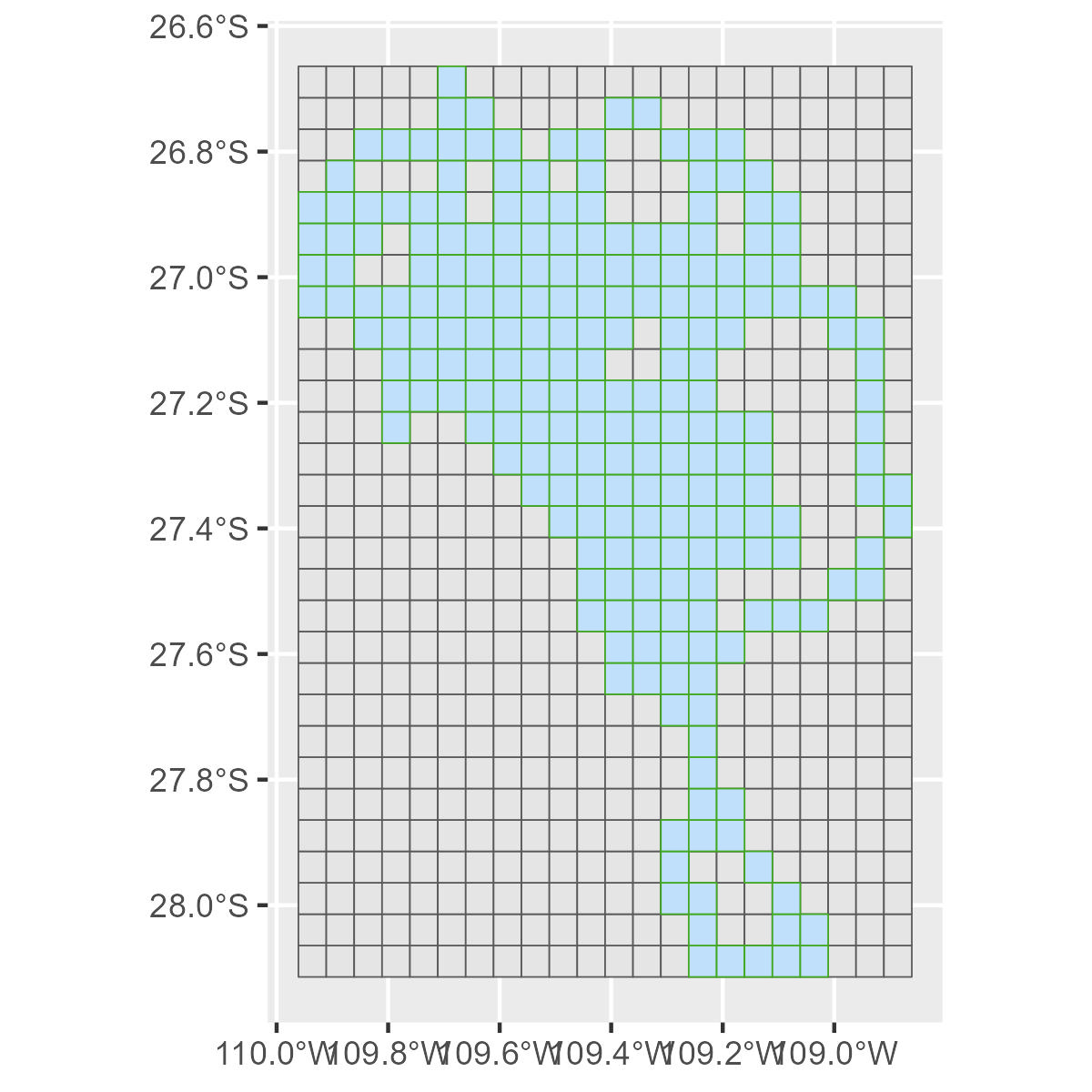my_data<-(sula::GPS_preparado)Grid, Raster, Colors
Create a grid, then a raster, and plot them with your custom colors.
Intro
The goal of this post is to:
1- Create a grid
2- Extract values per grid
3- Keep only grid cells with values
4- Calculate mean values per grid
5- Customize raster plot
Data
For this example, we will use the data provided in the package sula
The data is from tracked masked boobies at Rapa Nui
The data is already in tidy format
Grid
Start by converting the data from data.frame to an sf object using functions from the package sf
library(sf)Using the argument st_as_sf convert the data to a sf object
my_points<-my_data %>%
st_as_sf(coords=c('Longitude','Latitude'),
crs=4326,
remove=FALSE)For plotting the data use the package ggplot2
library(ggplot2)Since the data is an sf object, use the function geom_sf to plot
ggplot()+
geom_sf(data=my_points)+
theme_minimal()To create a grid using the points.
A common used method is the fish net. By definition, the fish net, or square grids, is a good method of covering a surface. The method is called tessellation, and it converts a surface with no overlaps or gaps, like when using tiles.
To create a grid the function st_make_grid can be used
The arguments of the function st_make_grid are:
n - an integer of length 1 or 2, which corresponds to the number of grid cells in x and y direction (columns, rows)
what - defines if polygons, corners or centers are to be created
square- is set to TRUE creates squares, if set to FALSE creates an hexagonal grid
To decide on the size of the grids, check the differences in latitudes and longitudes using the function range
range(my_points$Latitude)
range(my_points$Longitude)my_grid<-st_make_grid(my_points,
c(0.05, 0.05),
what = "polygons",
square = TRUE)Now that the grid has been calculated, transform the grid to sf using the function st_sf and add an grid_id to the grid cell using the function mutate from the package dplyr
library(dplyr)my_grid_sf = st_sf(my_grid) %>%
mutate(grid_id = 1:length(lengths(my_grid)))To plot the recently created grid:
ggplot()+
geom_sf(data=my_grid_sf)+
geom_sf(data=my_points)+
theme_minimal()Extract values per grid
Using the function st_intersection the values from the points can be added to the grid
Using the argument lenghts the sample number per grid can be calculated
my_grid_sf$nlocs <- lengths(st_intersects(my_grid_sf,
my_points))To add color to the plot, the package viridis provides the function scale_fill_viridis.
library(viridis)The color will correspond to the number of locations (nlocs)
ggplot()+
geom_sf(data=my_grid_sf,aes(fill=nlocs))+
theme_minimal()+
scale_fill_viridis(direction = -1) Surveyed
To keep only the grid cells that were surveyed, the grid cells that have 0 recording can be removed
grid_w_data = filter(my_grid_sf, nlocs > 0)To check which grid cells were removed, plot the previous and current grid
ggplot()+
geom_sf(data = my_grid)+
geom_sf(data = grid_w_data, colour = "#42a921", fill= '#bde0fe',alpha=0.9)+
NULL
Mean values
To calculate the mean values per grid, functions from the package tidyverse can be used
my_dens<-my_pointsFor the exercise, generate random data using the function runif
my_dens$densities<-runif(nrow(my_dens), min=0, max=1)To transform from data.frame to sf object the function st_as_sf can be used
my_dens_sf <-my_dens %>%
st_as_sf(coords = c("Longitude", "Latitude"))To assign the coordinate system the function st_set_crs can be used
my_dens_sf = st_set_crs(my_dens_sf , "EPSG:4326")Using the function st_intersection, the grid number to each data point is added
dens_grid <- st_intersection(grid_w_data,my_dens_sf)With the function mutate, the mean density per grid can be calculated
dens_mean <- dens_grid %>%
st_drop_geometry() %>%
group_by(grid_id)%>%
mutate(grid_dens_means=mean(densities))Finally, the mean density can be added to the general grid
grid_w_dens<-merge(grid_w_data,dens_mean, by='grid_id', all=TRUE)There might be more than one value per grid, to have one value per grid the function summarise_at can be used.
grid_dens<-grid_w_dens %>%
group_by(grid_id)%>%
summarise_at(vars(grid_dens_means),
list(name = mean)) %>%
rename(dens_mean=name)To remove grid without values, the function drop_na can be used
library(tidyverse)grid_dens<-grid_dens%>%
drop_na(dens_mean)To check the values that were removed, plot the data.
ggplot()+
geom_sf(data = grid_dens,aes(fill = dens_mean))+
geom_sf(data= my_dens_sf)+
scale_fill_viridis(direction = -1) Customize
The function geom_sf allows to plot a raster
Axis labels can be changed using scale_x_continuous and scale_y_continuous
To see less distracting colors on the background, theme_minimal is a prefered option
ggplot()+
geom_sf(data = grid_dens,aes(fill = dens_mean))+
scale_fill_viridis(direction = -1) +
scale_x_continuous(labels = function(x) paste0(x, '\u00B0', "W")) +
scale_y_continuous(labels = function(x) paste0(x, '\u00B0', "N"))+
theme_minimal()To make a custom raster palette the function scale_fill_gradientn can be used
dens_colors<-c('white','#6CB4D3','#1A89AB','#7CC252','#B2EC2B','#DCF754','#FFE454','#FD9708','#F6640F','#EC2C11')
dens_breaks<-c(0,0.30,0.60,0.85)
dens_labels<-c('0','0.30','0.60','> 0.85')The plot with custom palette arguments consider:
colours the number of colors should correspond to the values
breaks for those numbers that are to be displayed
labels for those labels that are to be displayed
limits to set up minimum and maximum values on the scale
To customize legend:
legend.key can be used
ggplot()+
geom_sf(data = grid_dens,aes(fill = dens_mean),color='transparent')+
scale_fill_gradientn(name='Density',
colours = dens_colors,
breaks = dens_breaks,
labels = dens_labels,
limits=c(0,1))+
scale_x_continuous(labels = function(x) paste0(x, '\u00B0', "W")) +
scale_y_continuous(labels = function(x) paste0(x, '\u00B0', "N"))+
theme_bw()+
theme(panel.background = element_rect(fill = '#3668b4'),
panel.grid.major = element_blank(),
panel.grid.minor = element_blank())+
theme(
legend.key = element_rect(color = "black",size=5),
legend.key.width = unit(1, "cm"),
legend.key.height = unit(1, "cm")) +
guides(fill = guide_colorbar(ticks.colour = "transparent"))